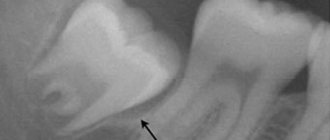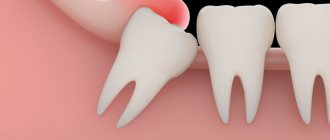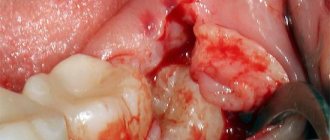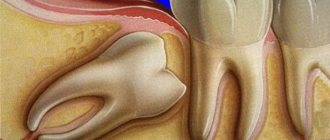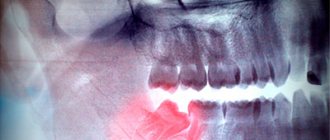For most people, the growth of wisdom teeth is accompanied not only by gum cutting and discomfort, but also by quite severe pain that makes it difficult to eat, concentrate on any task, and even sleep.
If the wisdom tooth grows and does not cause significant discomfort, no medical action may be taken. As a rule, the discomfort goes away after 1-2 weeks, but in order to avoid the manifestation of other problems, it is worth undergoing an examination at a dental clinic. However, if the gums from the wisdom tooth become inflamed, the local and general temperature rises, and specific aching pain is felt, immediately contact your dentist, he will conduct an examination and take the necessary measures to eliminate the problem.
Symptoms of wisdom tooth growth
During the period when a wisdom tooth comes in, a number of specific symptoms can be observed, by which it can be determined that the discomfort comes specifically from the eights:
- Discomfortable sensations in the tooth area, in some cases – gum thickening;
- Feeling of swelling in the gums;
- Increased local temperature, painful swelling;
- In the molar area, soft tissues (gums) become inflamed;
- Difficulty opening the mouth and swallowing. When opened wide, a sharp, aching pain is felt;
- There is a desire to chew any hard food or objects. After such chewing, the pain increases significantly;
- General increase in body temperature, general malaise and headaches.
Depending on the nature of growth, pain in wisdom teeth and specific symptoms can vary significantly. Regardless of how long a wisdom tooth grows - one or two weeks, it will cause certain sensations, and in case of complex or pathological growth - acute pain with inflammation of the gums.
An increase in general body temperature and swelling of the cheek indicates a severe course, as well as the possible development of pericoronitis - a complex disease of the oral cavity with a number of consequences.
How to accelerate growth?
It is impossible to speed up the process of teething: it depends on the characteristics of the whole organism and the structure of the jaw, the location and direction of the “eights”. In this case, only the symptoms can be eliminated.
But it is important to remember: heating the gum or cheek is strictly prohibited!
This provokes an acceleration of the inflammation process and the rapid spread of infection to the nearest teeth.
It is also not recommended to rinse the mouth with hot decoctions. It is best to use a decoction of salt and soda before going to the dentist: it has disinfecting properties, will remove food particles and reduce pain.
Under no circumstances should you cut the gum tissue yourself using sharp objects. This can lead to severe bleeding and infection.
Step-by-step process for wisdom tooth removal
The main causes of pain
Painful symptoms from wisdom teeth are caused by the anatomical features of the upper and lower jaw, which are already fully formed in a person at the age of 17-25.
As the figure eight begins to grow, it puts pressure on neighboring teeth, bone and soft tissue. The growth process can last for months and even years, so pain manifestations are temporary, periodically fading and exacerbating.
The pain of tooth 8 can be provoked not only by its growth or anatomically incorrect position, but also by the presence of various pathologies, for example, caries, pulpitis, periodontitis or a wide range of infectious diseases. Note! The lack of timely professional help can provoke a worsening of the situation, which will result in the need to remove the diseased tooth and treat complications.
How long do eights grow?
The process takes place individually. At what age a wisdom tooth can erupt depends on its readiness. By the age of 17, its main part (crown) is just beginning to form. The roots are still in progress. This will continue for about 3-4 years. In the range of up to 40 years, you can expect its appearance from the gums. For each person, this process occurs differently in terms of time and symptoms. The Guinness Book of Records records the latest case at 94 years. Some people experience a whole list of unpleasant symptoms with pain and fever, while for others everything happens quietly and calmly. At what age wisdom teeth erupt is a secondary matter. The speed of appearance is influenced by the size of the jaw. If there is not enough space, it will be difficult for the crown to come out of the gums.
How to relieve pain if a wisdom tooth grows and your gums hurt.
The growth of wisdom teeth is not painless for every person, so most people need to know what to do in case of inflammation of the gums around the wisdom tooth and acute aching pain.
If there is inflammation, pain, or if the cheek is swollen near the wisdom tooth, you should contact your dentist, he will conduct an examination and take the necessary measures to eliminate symptomatic manifestations.
If the pain begins in the evening or it is not possible to quickly contact a specialized specialist, doctors recommend several ways to reduce pain:
- Rinse the growth with calendula tincture after eating - this will reduce the intensity of the inflammatory process and also reduce pain;
- Rinse your mouth with a solution of baking soda in water, at the rate of 1 teaspoon of soda per 1 glass of water (200 grams) - soda calms inflammation and also reduces pain;
- To rinse the mouth, you can use decoctions of chamomile, oak bark, chicory root, as well as sage tincture and propolis;
- Anti-inflammatory, painkillers and antibacterial drugs - use according to the instructions. They help reduce pain, reduce swelling, and also eliminate the negative bacterial influence at the site of tooth eruption.
In case of acute unbearable pain, as well as the absence of the above remedies, you can use cold water to reduce pain: take a glass of cool water, put a small amount in your mouth and hold it in the area where the wisdom tooth is erupting - this can quickly reduce the level of pain. However, this method has one negative feature - the pain intensifies almost immediately after stopping holding cool water at the site of gum inflammation, for example, near the hood of a wisdom tooth.
Molar growth process
With proper growth, figure eight teeth do not cause any particular trouble to the patient. The physiological process ends with the vertical position of the extreme molar, which eliminates changes in bite, caries and the formation of a hood.
The patient may complain only of slight redness and thickening of the gums, mild pain, which can last from several days to a month.
During the eruption of extreme molars, some pathological phenomena may occur.
Most often, these include tooth deviations from vertical growth:
- The process of tilting the molar forward towards the seven is called medial tilt.
The process of tilting the molar forward towards the seven is called medial tilt. It can provoke the onset of caries in a neighboring tooth, the reason for this is constant pressure on the enamel and the accumulation of microorganisms in the gap formed between them.
- With a distal tilt , when the figure eight grows backward, its urgent removal is necessary.
- The eruption of a molar towards the cheek is accompanied by damage to its mucous membrane. The buccal tilt of the tooth can provoke malignant tumors at the site of damage.
- During horizontal and linguistic growth, compression of the roots of sevens , sixes and fives occurs. This causes an inflammatory process that requires immediate removal.
Where can I get dental care in Orenburg?
If your gums hurt where your wisdom teeth are, you can get qualified dental care in two places: public and private dental clinics. During the appointment, the dentist must:
- Conduct a preliminary examination of the oral cavity, determine the exact cause of the development of painful symptoms;
- If necessary, refer the patient for an x-ray - this procedure is often necessary in the presence of impacted wisdom teeth (completely or partially covered by gum), as well as in the case of surgical removal;
- Take the necessary measures to reduce or eliminate pain and swelling, as well as prevent further aggravation of the situation;
- If necessary, refer to a dental surgeon to remove third molars;
- Provide recommendations for further dental and oral care.
Do your gums hurt and you have symptoms of wisdom tooth growth? Seek qualified help from specialized specialists!
How to prevent pain
To reduce the risk of inflammatory processes in the socket and the development of pain, the doctor gives the patient recommendations on how to behave immediately after extraction:
- hold a sterile swab between the teeth, which is placed to stop gum bleeding for at least 20 minutes;
- refrain from eating for 2–3 hours after removal;
- take a painkiller tablet in the first 1–2 hours after the wisdom tooth root has been removed, Ketorol, Ketanov, Baralgin are suitable;
- avoid smoking, alcoholic beverages, spicy foods, hot and cold drinks, physical activity on the first day;
- rinse with antiseptic solutions Furacilin, Chlorhexidine, chamomile decoction, starting from the second day after extraction (this cannot be done earlier, so that a blood clot will form in the hole, it will protect the wound from infection);
- apply antiseptic ointments and gels to the affected area - Metrogyl Denta, Asepta, Cholisal, Solcoseryl.
Antibacterial drugs are usually prescribed in cases where a tooth has been pulled out, surrounded by suppuration or with flux located nearby. Then the patient is required to take the drugs for at least 5–7 days in a row, in order to avoid recurrent complications
As you can see, modern dentistry has stepped far forward, giving patients the opportunity to remove problem teeth painlessly and with the least risk of complications. The drugs used today for anesthesia do not cause side effects or allergies, have a quick and long-lasting effect, allowing you to reduce discomfort to a minimum. After extraction, you do not need to go to the dentist to remove the sutures again - doctors use self-absorbing threads, as they save the tissue from additional trauma.
An important point is the psychological mood of the patient himself. Having read and heard stories about terrible pain during tooth extraction, a person delays a visit to the doctor, provoking complications that can be avoided by seeking help in a timely manner. Therefore, you should not be afraid of the dental chair - the doctor will do everything possible to ensure that the patient does not experience discomfort, and the fear of dentists is a thing of the past.
At what age do third molars appear?
There are no “eights” in the milk bite. Moreover, their rudiments are not laid during the intrauterine development of the fetus; this process begins only closer to 4-5 years. Crowns are finally formed by 11-12 years, and roots only by 24-26 years. It is believed that around this period they begin to break out. But in practice, situations are common when they appear much later, for example, after 30 years. Or they don’t make their way out at all until the end of life, or they appear only partially (not in full).
Where did teeth get their name?
One of the theories, so to speak, “folk”, is associated with late periods of eruption. Allegedly, after 20 years of life, a person has already gained some experience and become wiser.
The scientific or “Darwinian” theory says that this happened during evolution. Human ancestors, monkeys, used their teeth not only for chewing and grinding food, but also for turning improvised devices and tools and participating in fights, so they lost them in their youth. And the third molars appeared late precisely so that the monkeys, already in old age, could at least somehow process food.
When pain is normal
When a tooth is cutting and your gums hurt, this condition can be considered normal. The sensations should not be too sharp; they are rather nagging and dull, monotonous, aching.
Do not forget that the tooth began to emerge in adulthood; it did not have a milk predecessor that would have left behind a “beaten path.” The bone tissue of an adult has finally formed, the gums are dense and thick, and it is natural that the third molar injures and damages tissue and touches nerve endings when it passes through them.
What complications may arise during horizontal eruption?
- wisdom teeth can contribute to the displacement and tilt of “sevens”, “fives” and “fours” towards the center of the jaw: in this situation they act almost on the principle of braces. True, the effect will not be positive, but negative, because crowding will appear in the frontal zone, and the bite will be disturbed,
- they can destroy the adjacent seventh tooth, its crown and even the bone tissue around it.
What to do if the third molar is cut during pregnancy
If a wisdom tooth is cut incorrectly or irregularly during pregnancy, then the first thing a woman needs to do is see a dentist. This process requires close monitoring. The expectant mother cannot undergo surgical manipulations, so the main task is to prevent acute inflammation, which will make it necessary to take drastic measures - to remove the third molar.
To relieve symptoms, a woman can be prescribed antiseptics (for example, Miramistin), rinsing with herbal decoctions, as well as painkillers that are acceptable for the trimester of pregnancy in which she is.
Read about when dental intervention is permissible during pregnancy in the article on the website.
If there is an emergency need to remove a tooth, the doctor must assess all possible risks and conduct a thorough assessment of the health of the expectant mother and child.
What measures will help with pericoronitis?
If there is no active inflammatory process, then at home you can perform antiseptic treatment of the oral cavity using Chlorhexidine or Miramistin. To eliminate the pain symptom, doctors advise using drugs from the group of non-steroidal anti-inflammatory drugs with ibuprofen - Ibuprofen, Paracetamol, Diclofenac. Local applications of Cholisal, Kamistad, and Kalgel gels, which have an anesthetic and anti-inflammatory effect, will also help.
On a note! Rinse with antiseptics at least twice a day - always in the morning after breakfast and oral hygiene, and in the evening after brushing. The duration of one procedure should be at least 1 minute.
If the inflammation is acute and complicated by the accumulation of pus, then you need to consult a doctor who will excise the hood hanging over the figure eight. Next, the scheme is the same - anti-inflammatory drugs, antiseptics and gels at home.
Provided that there is not enough space for the third molar to erupt on the jaw, excision of the hood will only give a temporary effect, and the inflammation will recur, so the doctor may decide to remove it.

